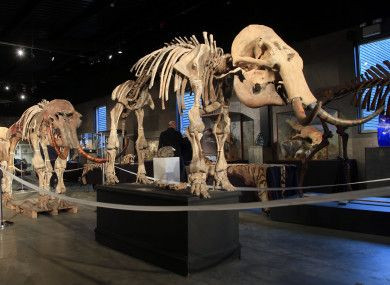10,000-Year-Old Woolly Mammoth Skeleton Sold For $645,000 In France

A 10,000-year-old woolly mammoth skeleton found in Siberia about 10 years ago was sold for $640,000 (€548,000) at an auction Dec. 16 to French waterproofing company Soprema.
France-based auctioneer Claude Aguttes revealed on Twitter the auction happened in the Aguttes auction house in the French city of Lyon and the skeleton was sold to Pierre-Etienne Bindschelder, CEO of Soprema. The company’s logo is a mammoth and the skeleton will be displayed in the lobby of Soprema’s main office.
Mammouth adjugé 548000€ à Lyon. L’acheteur , présent dans la salle, est le patron de la Soprema dont le produit phare est le Mammouth ! Assaut des journalistes ... pic.twitter.com/ieDbXoChjv
— Claude Aguttes (@CAguttes) December 16, 2017
It is known the specimen measures 3.4 meters high and has both tusks intact, each measuring a whopping 11 feet. It is one of the largest and most complete fossil found of a woolly mammoth with nearly 80 percent of its structure intact. The rest was filled with resin and the fossil was given an imposing walking-pose as seen in file images from the museum.
The skeleton was found by a hunter in Siberia about 10 years ago. Scientists who examined it noticed the teeth of this male mammoth had decayed, suggesting the animal probably died due to starvation after being unable to graze. The animal was estimated to weigh around 3,000 pounds, said a press report by news website the Journal.
In the past, humans found vast field of mammoth fossils. Recent reports circulating the internet claimed a mammoth skull was found while digging an extension of the Los Angeles subway system.
Woolly mammoths were once among the most common herbivores in North America and Siberia, but came under threat from increased hunting pressure and a warming climate.
Most mammoths disappeared with the ice age around 10,000 years ago, but a small population of about 1,000 mammoth lived on the remote Wrangel Island in the Arctic until about 4,000 years ago.
A study in PLOS Genetics, which compared the genes of a mammoth that lived during the peak of the species, about 45,000 years ago, to a mammoth that lived during the final stages of its demise, showed a devastating and ugly end to a once-powerful animal. Negative gene mutations took over due to a mammoth version of inbreeding, as the small number of creatures tried to hang on.
Mammoth remains were frequently discovered in Siberia and Russia’s extreme northern regions where they were preserved in the frozen earth.
The first complete mammoth skeleton to be sold at auction in France garnered €150,000 ($176310) in 2006. Another was sold in October 2012 in Paris for €240,750 ($282989) at an auction organized by Sotheby’s.
In 2014, a South Korean company called SOOAM even analyzed liquid blood samples from the well-preserved specimen and tested for complete strand of DNA. They hope to clone a mammoth if the right biological data is found. A specimen of woolly mammoth, called "Buttercup," was discovered in 2013 in Siberia.
In 2017, scientists from Harvard said that they may be close to resurrecting traits of a woolly mammoth, which could undergo “de-extinction,” according to a scientist leading the Harvard team attempting to resurrect the beast.
© Copyright IBTimes 2025. All rights reserved.





















